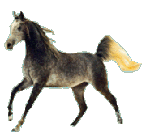Winter: forages, hay vs. grain, warmth...
FEEDING FOR THE SEASON.
This is the season I spend a great deal of time thinking about feeds and feeding. Fortunately we humans have the liberty to choose the foods that are good for us, but usually eat the other stuff instead. Our horses do not have this liberty, and pretty much have to take the feeds we give them.
For this article we will be referring to the horse in medium condition and allowed to run out. The feeds we give the horses can be divided into grains and forages. Grass and hay make up the forages. Oats, corn, and the grain mixtures make up most of the grains or concentrates.
The horse has lived for several million years on forages. Their digestive system is engineered to breakdown and digest grasses. So it would make sense that this is all the horse needs for maintenance. However, there is a very good argument for some grain supplementation. Apparently one big benefit the knights of the crusading armies of Europe had was the grain fed horse. This horse was much larger and stronger than those of the wandering tribes, and could carry the great weight of the armor for themselves and the rider. Of course their time also passed,. due in large part I suspect to the difficulty in movement and going to the toilet. The point of all this history is that the horse will respond to grain feeding with faster growth, achieving its genetic potential sooner.
Another impression is that feeding grain helps keep the horse warm during cold weather. The two to three percent fat in the grain does provide calories which, during digestion, give off heat. Digestion of grain is very rapid due to its high digestibility. As a result, any benefit of the heat given off is gone within a very few hours. If the horse is under weight, extra grain may be needed to provide extra fat reserves.
Hay and grass take a considerable time to be digested. They must be broken down into small particles by chewing and by the first half of the stomach. Once this is accomplished, the acid of the stomach goes to work to break down the fiber. Once the fiber is digested, it moves on into the small intestine where the nutrients are broken down and absorbed by the blood. Finally, within the large intestine the remaining fibers are compressed into the familiar biscuits and eliminated. This all takes many hours. The coarser the hay, the longer it takes. During the process of digestion, heat is released. This heat provides the horse much appreciated warmth during the winter, and for a much longer time than the concentrates.
The purpose of all this is to remind us of the importance of hay during the winter. If the horse is in good condition and is not pregnant or being ridden often, then forages alone will probably provide all it needs for maintenance. If they do need concentrates, these should not replace the forages but supplement them. We should also consider feeding a better quality of hay if there is a need for more nutrients. Even if you are feeding a high quality alfalfa hay, please keep in mind the need for roughage. Often this premium quality very expensive hay is fed as the only roughage source. The high protein and fine stems may lead to loose stools or even irritation of the bowel. Feeding some grass hay at the same time will allow the horse to mix the two. They will do this on their own if both hays are available. They listen to their intestines and know when to slow things down with a coarser, less digestible hay.
In summary:
May Dobbin and the entire hitch have to struggle in bringing to you all the loads of good health, good cheer, and good fortune for the holiday season.
CLICK BELOW TO DISPLAY A PRINTER-FRIENDLY COPY OF THIS ARTICLE
Select "Open this file from its current location," if you just want to print it out,
it will open in a simple word processing application, select the print button.
(unless you want to save this article in your computer's memory)

 feedingfortheseason.txt
feedingfortheseason.txt